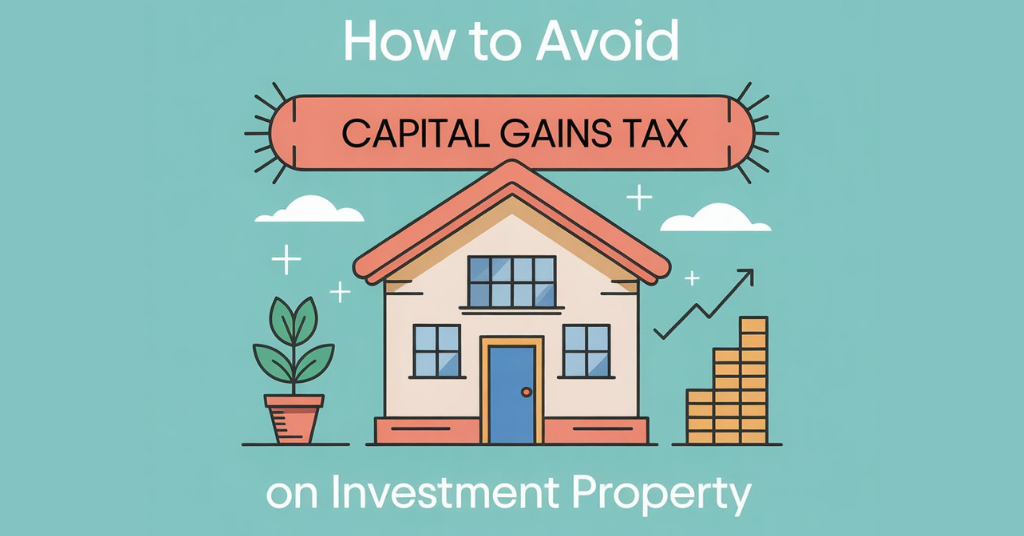Investing in property can be a great way to build wealth in Australia. However, when it comes time to sell, Capital Gains Tax (CGT) can take away a significant part of your profit. The good news is that there are legal strategies for how to avoid capital gains tax on investment property.
In this detailed guide, we’ll explain how CGT works in Australia, how it’s calculated, and the top strategies you can use to minimise your tax burden — all explained in simple language with real-life examples.
🏠 What is Capital Gains Tax (CGT)?
Capital Gains Tax (CGT) is the tax you pay on the profit (capital gain) you make when you sell an asset like an investment property, shares, or land.
In Australia, CGT is part of your income tax — it’s not a separate tax.
If you sell your investment property for more than you paid for it, the profit is considered a capital gain and must be declared in your annual tax return.
Example
- You bought an investment property in Sydney for $600,000 in 2015.
- You sold it in 2025 for $900,000.
- The capital gain = $900,000 − $600,000 = $300,000.
You don’t automatically pay 100% tax on this $300,000; the taxable amount depends on various factors we’ll discuss below.
📊 How to Calculate Capital Gains Tax
To calculate CGT on a property, follow these simple steps:
- Calculate your cost base (purchase price + buying costs + improvement costs).
- Find your selling price (sale amount − selling costs).
- Subtract cost base from sale price = Capital Gain.
- Apply CGT discount (if eligible).
- Add the taxable gain to your annual income to determine the final tax payable.
Example Calculation
Let’s say:
- Purchase price: $600,000
- Stamp duty, legal, and agent fees: $25,000
- Renovations: $35,000
- Selling price: $900,000
- Selling costs (agent commission, etc.): $20,000
Cost base = $600,000 + $25,000 + $35,000 = $660,000
Capital Gain = $900,000 − ($660,000 + $20,000) = $220,000
If you’ve owned the property for more than 12 months, you can apply the 50% CGT discount (if you’re an individual).
✅ Taxable Capital Gain = $220,000 × 50% = $110,000
If your annual income is $100,000, your taxable income now becomes $210,000, and your CGT is calculated according to your marginal tax rate.
💡 Legal Ways: How to Avoid Capital Gains Tax on Investment Property in Australia
Here are the top strategies Australians use to legally avoid or minimise CGT:
1. 🏡 Use the Main Residence Exemption
If you live in the property as your main residence, it may be completely exempt from CGT when sold.
However, if it’s an investment property, you can still claim a partial exemption if you lived in it for a while.
Example
- You bought a property in 2012 and lived there for 3 years.
- Then you rented it out for 5 years.
- You sell it in 2025.
You can claim 3 years of exemption + up to 6 years of CGT-free status under the “6-year rule” if you didn’t buy another main home during that time.
✅ This means the entire gain could be exempt from CGT if sold within that period.
2. ⏳ The 6-Year Rule (Temporary Absence Rule)
The ATO allows you to treat your property as your main residence for up to 6 years after you move out, even if you rent it out.
So, if you sell within those 6 years, you don’t pay any CGT at all.
Tip:
Keep records of:
- The date you moved out
- Rental periods
- Any major renovations
These records help you claim your CGT exemption accurately.
3. 🧾 Apply the 50% CGT Discount
If you hold your investment property for more than 12 months before selling, you’re eligible for a 50% CGT discount (for individuals and trusts).
Example
If your capital gain is $200,000, only $100,000 is taxable.
✅ This is one of the easiest and most effective ways to cut your CGT in half.
4. 🏗️ Add to Your Cost Base (Record All Expenses)
Many property owners forget that certain costs can be added to the cost base, reducing the taxable gain.
These include:
- Stamp duty
- Legal fees
- Building inspections
- Loan establishment fees
- Renovations (that improve value)
- Marketing and selling costs
Example
If you spent $20,000 on renovations, you can add it to your cost base and reduce your taxable gain accordingly.
5. 💼 Offset Losses with Other Investments
If you made a capital loss (e.g., from shares or another property sale), you can offset it against your capital gain from your investment property.
Example
- Gain from property sale: $150,000
- Loss from share investment: $30,000
✅ Taxable capital gain = $150,000 − $30,000 = $120,000
This simple strategy can save you thousands in tax.
6. 🧮 Time the Sale for a Lower Income Year
CGT is added to your taxable income, so the higher your income, the higher your CGT rate.
If possible, plan the sale for a year when:
- Your income is lower (e.g., retirement, career break), or
- You can offset income with deductions or business losses.
Example
If you sell during a year your income is $50,000 instead of $120,000, you’ll likely fall into a lower tax bracket, reducing your total CGT payable.
7. 👨👩👧 Joint Ownership Benefits
If you co-own the property with your spouse or family member, each person is only taxed on their share of the capital gain.
Example
If a property made a gain of $200,000 and you own it 50/50 with your spouse:
- Each person reports $100,000 gain.
- Then each can apply the 50% discount, making the taxable gain $50,000 each.
✅ This reduces the total tax paid as it’s spread across two taxpayers.
8. 🏦 Use Superannuation (SMSF Strategy)
If you own or plan to buy property through a Self-Managed Super Fund (SMSF):
- CGT is 15% during accumulation phase.
- It can be 0% during pension phase (if conditions are met).
This can be a powerful long-term strategy to reduce or eliminate CGT entirely on investment property sales.
9. 🏗️ Reinvest in Property Improvements
Major improvements (like extensions or kitchen upgrades) can be added to your cost base, thus reducing your capital gain.
But remember — only capital improvements count, not repairs or maintenance.
Capital improvement example:
Adding a new room or swimming pool = ✅ add to cost base.
Repainting walls or fixing leaks = ❌ cannot add.
10. 🕓 Use the 12-Month Rule Smartly
If you’re close to the 12-month ownership mark, wait before selling.
Selling just a few weeks early can mean losing the 50% CGT discount.
So always check your settlement date, not the contract date, to ensure you’ve passed the 12-month threshold.
📘 Common Mistakes to Avoid
- ❌ Not keeping proper records of improvement costs.
- ❌ Confusing repair costs with capital improvements.
- ❌ Selling too early without using the 12-month rule.
- ❌ Forgetting the 6-year rule.
- ❌ Ignoring opportunities to offset losses.
Keeping detailed records and seeking professional advice can help you claim every possible deduction and exemption.
📑 Record-Keeping Tips (As per ATO)
According to the Australian Taxation Office (ATO), you must keep:
- Purchase and sale contracts
- Legal and agent invoices
- Renovation receipts
- Loan documents
- Evidence of ownership period and rental history
Keep all records for at least 5 years after selling the property.
🧮 Quick Example: Full CGT Calculation in Australia
| Details | Amount (AUD) |
| Purchase price | $500,000 |
| Buying costs (stamp duty, legal) | $25,000 |
| Renovations | $25,000 |
| Selling price | $800,000 |
| Selling costs | $15,000 |
| Capital Gain | $800,000 – ($500,000 + $25,000 + $25,000 + $15,000) = $235,000 |
| CGT discount (50%) | $117,500 taxable gain |
| Annual income | $90,000 |
| Total taxable income | $207,500 |
| Approximate CGT payable (at 37%) | ≈ $43,475 |
✅ By timing the sale or offsetting losses, you could easily reduce this amount significantly.
Also Read: How to Buy an Investment Property: A Step-by-Step Guide
📍 Final Thoughts
Avoiding capital gains tax in Australia doesn’t mean breaking the law — it means using the rules smartly to your advantage.
By applying strategies like the main residence exemption, 6-year rule, 50% CGT discount, and offsetting losses, you can legally reduce or even eliminate your CGT.
Always remember, planning ahead and keeping proper records are key to saving thousands in taxes.If you’re unsure which strategy suits your situation best, consult a registered tax agent or financial advisor before selling your investment property.



